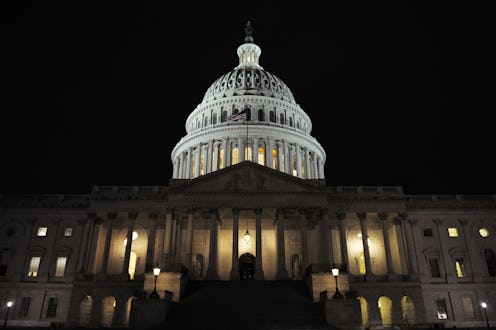News
The One Way Republicans Could Lose Senate Control
One of the main questions the 2016 Democratic presidential candidates have faced on the debate stage so far is: How can you get anything done in a Republican-controlled Senate? The question is certainly worth asking, given the amount of obstructionism President Obama has faced — the refusal of Senate Republicans to even meet with Obama's forthcoming Supreme Court nominees is the most poignant example of late. Now, with Sec. Hillary Clinton and Sen. Bernie Sanders promising progressive changes in social and economic policy on the campaign trail, we're left to wonder how they could pull any of it off working with the current "Do Nothing" Congress. Part of the answer could involve Democrats regaining control of the Senate in the Nov. 8 general election — a perhaps difficult but not impossible feat. Its success or failure may hinge on voter turnout.
Control of the Senate matters so much because this branch of Congress has quite a bit more power than the House in a number of ways, according to About.com. For example (as has been brought to the fore since Justice Antonin Scalia's death), the Senate is responsible for confirming judicial appointees — not just in the nation's highest court, but in the lower courts as well. It also must confirm presidential Cabinet members. But the Center of American Progress elaborated on the ways in which the Senate's powers enable it specifically to delay and block legislation. Senators can hold endless debates on a piece of legislation, and it takes 60 senators to move the legislation forward to a vote (a significant majority out of 100 total senators).
Republicans currently have control of both the House and the Senate. This, combined with a consideration of just how polarized the parties have become, means it's extremely difficult to get any progressive legislation passed through the normal process (executive actions on the presidential level are possible in some cases, but controversial). Ballotpedia explained that 34 Senate seats are up for reelection in 2016, and Democrats would need to gain five of them to have a majority in the Senate (compared to the 30 they would need to take over the House). Democrats will be more likely to gain control of the Senate with a big voter turnout in November, with an eye not only toward the presidential election but the congressional election as well.
Keeping in mind that more than half the states have yet to cast their primary ballots, so far, Republican turnout at the primaries has been record-breaking, whereas Democratic turnout has been lower than the massive numbers from 2008. According to Pew Research, 17.3 percent of eligible voters turned out for Republican primaries and caucuses so far, compared to 11.7 percent on the Democratic side.
However, though Democratic turnout was not fantastic in the earliest primaries, in March, things began to pick up. The Elections Project voter turnout data shows slight increases of about 1,500 to 3,000 voters in the Colorado, Maine, and Kansas Democratic caucuses from 2008 to 2016, marking small record-breaks.
Those slight increases on the Democratic side pale in comparison to Republican turnout thus far. However, we should note PolitiFact's recent fact check of David Brooks' statement that primary voter turnout does not predict which side will win the general election — meaning, which side will have more turnout in November. He was right; there's no correlation. Still, the fact that Republican turnout is breaking records left and right (turnout in the 11 Super Tuesday states was a whopping 81 percent higher than in 2012) may be a bit unsettling to those who don't want a Republican president or a continued Republican Congress.
What is certain is that, if voters want progressive changes in the coming years, voting in a Democratic president is not enough; taking control of the Senate will be a crucial move to begin the work of loosening legislative gridlock.
